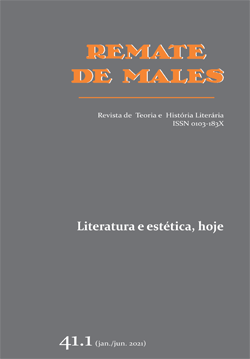Abstract
The definition of “literary form” is the key access to Adorno’s Aesthetics. Adorno has a literary conception of art, with a profound humanistic signification. The condition of this definition depends on the medial strucuture of the society he deals with. Actual Aesthetics is not driven by the same effort, by reason of the changed medial conditions. It’s possible to understand this, if you observe the development of different contemporary philosophies of art. But it’s possible as well if you describe the writing style of the contemporary german philosopher Peter Sloterdijk, whose “narrative form” of construction of theory is, at the same time, an original legacy of Adorno’s Aesthetics and a transformation of his critical injunction.
References
ADORNO, Theodor W. Erpresste Versöhnung. Zu Georg Lukács’s “Wider den missverstandenen Realismus”. In: Noten zur Literatur II. Gesammelte Schriften, Band 11. Frankfurt a.M.: Suhrkamp, 1961.
ADORNO, Theodor W. Filosofia na nova música. Perspectiva: São Paulo, 1974a.
ADORNO, Theodor W. Ist die Kunst heiter? In: Noten zur Literatur. IV, Gesammelte Schriften, Band 11. Frankfurt a.M.: Suhrkamp, 1974b.
ADORNO, Theodor W. Drei Studien zu Hegel. In: Gesammelte Schriften. Band 5. Franfurt a.M.: Suhrkamp, 1990.
ADORNO, Theodor W. Kierkegaard. Konstruktion des Ästhetischen, in Gesammelte Schriften. Band 2. Franfurt a.M.: Suhrkamp, 2003a.
ADORNO, Theodor W. O ensaio como forma. In: Notas de literatura I. São Paulo: Duas Cidades/Editora 34, 2003b, pp. 15-45.
ADORNO, Theodor W. Posição do narrador no romance contemporâneo. In: Notas de Literatura I. São Paulo: Duas Cidades/Editora 34, 2003c, pp. 55-64.
ADORNO, Theodor W. Dialettica negativa. Torino: Einaudi, 2004.
ADORNO, Theodor W. Teoria estética. Lisboa: Edições 70, 2008.
BEHLER, Ernst Irony and the Discourse of Modernity. Seattle/London: University of Washington Press, 1990.
BENASSI, Stefano; PULLEGA, Paolo (Eds.). Il saggio nella cultura tedesca del ‘900. Bologna: Cappelli, 1989.
BERNSTEIN, Jay M. The Fate of Art: Aesthetic Alienation from Kant to Derrida and Ador¬no. Cambridge: Polity Press, 1992.
BERNSTEIN, Jay M. Adorno: Disenchantment and Ethics. Cambridge: Cambridge University Press, 2001.
BLOCH, Ernst. Subject-Object. Erläuterungen zu Hegel. Frankfurt a.M.: Suhrkamp, 1962.
BLUMENBERG, Hans. Anthropologische Annäherung an die Aktualität der Rhetorik. In: Wirklichkeiten, in denen wir leben. Aufsätze und eine Rede. Stuttgart: Reclam, 1981, pp. 104-136.
BODEI, Remo. Immaginare altre vite. Realtà, progetti, desideri. Milano: Feltrinelli, 2013.
BONAIUTI, Gianluca. L’offesa dei sistemi, ovvero l’arte esplicitata ai fini della sua riproduzione. Iride, XXXII, n. 86, gen.-apr. 2019, pp. 145-153.
CAMPANELLI, Vito. L’utopia di una società dialogica. Vilém Flusser e la teoria delle immagini tecniche. Bologna: Luca Sossella editore, 2015.
CIXOUS, Hélène. Le Rire de la Méduse. L’Arc, v. 61, 1975, pp. 39-54.
DANTO, Arthur. After the End of Art: Contemporary Art and the Pale of History. Princeton: Princeton University Press, 1997.
D’ERAMO, Marco. Il selfie del mondo. Indagine sull’età del turismo. Milano: Feltrinelli, 2017.
de DUVE, Thierry. Kant after Duchamp. Cambridge: MIT Press, 1998.
EISELEIN, Gregory. Society as Communication, Art as Communication, and the Para-doxes of Autonomous Systems. The Review of Communication, v. 2, n. 1, 2002, p. 41.
FARINA, Mario. La dissoluzione dell’estetico. Adorno e la teoria letteraria dell’arte. Macerata: Quodlibet, 2018.
FLUSSER, Vilém. O universo das imagens técnicas. Elogio da superficialidade. Annablume: São Paulo, 2008.
GOLDING, John. Paths to the Absolute. Mondrian, Malevich, Kandinsky, Pollock, Newman, Rothko and Still. Princeton: Princeton University Press, 2000.
GOLDMANN, Lucien. L’illuminismo e la società moderna. Torino: Einaudi, 1967.
GREENBERG, Clement. Homemade Esthetics: Observations on Art and Taste. Oxford: Oxford University Press, 1999.
GROYS, Boris. Uber das Neue. Miinchen: Carl Hanser Verlag, 1992.
HABERMAS, Jürgen. O discurso filosófico da Modernidade. Lisboa: Publicações Dom Quixote, 1998.
HEGEL, Georg. W. F. Cursos de estética, I. São Paulo: Edusp, 2001.
HEIDEGGER, Martin. Wozu Dichter? In: Holzwege. Gesamtausgabe, Band 5. Frankfurt a.M.: Klostermann, 1977.
JONGEN, Marc. La resurrezione dalla non-morte. Sloterdijk trainer dell’iperimmaginazione. aut-aut, 355, lug.-set. 2012, pp. 37-56.
LUHMANN, Niklas. Die Kunst der Gesellschaft. Franfurt a.M.: Suhrkamp, 1995.
LUHMANN, Niklas. Die Realität der Massenmedien. Opladen: Westdeutscher Verlag, 1996.
MacCANNELL, Dean. The Tourist. A New Theory of the Leisure Class. Berkeley: University of California Press, 1976.
MACHO, Thomas. “Kultur ist eine Ordensregel”. Zur Frage nach der Lesbarkeit von Kulturen als Texten. In: NEUMANN, Gerhard; WEIGEL, Sigrid (Eds.). Lesbarkeit der Kultur. Literaturwissenschaft zwischen Kulturtechnik und Ethnographie. Münçhen: Fink, 2000, pp. 223-244.
MAINA, Giovanna; ZECCA, Federico. Harder than Fiction: The Stylistic Model of Gonzo Pornography. Porn Studies, v. 3, n. 4, 2016, pp. 337-350.
MARQUIS, Alice G. Art Czar: The Rise and Fall of Clement Greenberg. Boston: MFA Publications, 2006.
MATTEUCCI, Giovanni (Ed.). Adorno e la teoria estetica (1969-2019). Nuove prospettive critiche. Milano: Aesthetica, 2020.
MENNINGHAUS, Winfried. Die Versprechen der Schönheit. Frankfurt a.M.: Suhrkamp, 2003.
MÜHLMANN, Heiner. Countdown. 3: Kunstgenerationen. Wien: Springer, 2008.
NIETZSCHE, Friedrich. Humano, demasiado humano II. In: Obras incompletas. São Paulo: Abril, 1974.
SCHLEGEL, Friedrich. O dialeto dos fragmentos. São Paulo: Iluminuras, 1997.
SLOTERDIJK, Peter. Selbstversuch. Ein Gespräch mit Carlos Oliveira. München: Carl Hanser Verlag, 1996.
SLOTERDIJK, Peter. Luhmann, Anwalt des Teufels. Von der Erbsünde, dem Egoismus der Systeme und den neuen Ironien. In: Nicht gerettet. Versuche nach Heidegger. Frankfurt a.M.: Suhrkamp, 2001a, pp. 82-141.
SLOTERDIJK, Peter. Was ist Solidarität mit Metaphysik im Augenblick ihres Sturzes? Notizen über kritische und übertriebene Theorie. In: Nicht gerettet. Versuche nach Heidegger. Frankfurt a.M.: Suhrkamp, 2001b, pp. 235-274.
SLOTERDIJK, Peter. Sphären. Plurale Sphärologie. Band III: Schäume. Frankfurt a.M., 2004, pp. 523-533.
SLOTERDIJK, Peter. Du mußt dein Leben ändern: Über Anthropotechnik, Suhrkamp, Frankfurt a.M.: Suhrkamp, 2009.
SLOTERDIJK, Peter. Für eine Architektur der Teilhabe. In: Der ästhetische Imperativ. Schriften zur Kunst. Frankfurt a.M.: Suhrkamp, 2014, pp. 207-216.
SLOTERDIJK, Peter. Polyloquien. Frankfurt a.M.: Suhrkamp, 2018.
TUCHMAN, Maurice (Ed.). The Spiritual in Art: Abstract Painting (1890-1985). Los Angeles: Los Angeles County Museum of Art, 1986.
VALERY, Paul. Eupalinos ou O arquiteto. São Paulo: Editora 34, 1996.
WARBURTON, Nigel. The Art Question. London: Routledge, 2003, pp. 80-85.

This work is licensed under a Creative Commons Attribution-NonCommercial 4.0 International License.
Copyright (c) 2021 Gianluca Bonaiuti


